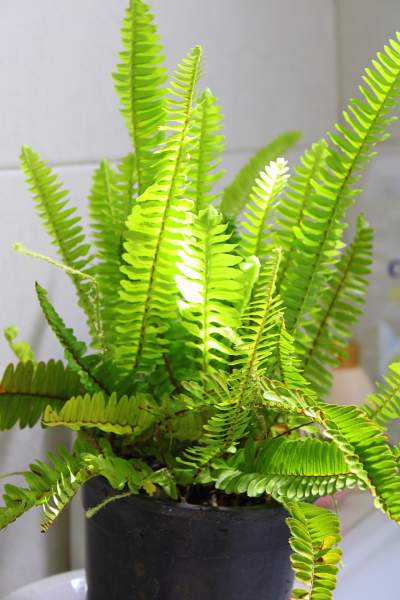The perennial herbaceous plant is also known as the sword fern. Boston fern is native to the tropical region in the world. It is the species in the family of Lomariopsidaceae and it is consists of 30 tropical varieties. Boston fern is used to decorate the balcony and it can grow quickly.

Boston fern is a popular houseplant and it is essential to take care of Boston fern to keep healthy. Let us know how to take care of Boston fern is not difficult but it is specific. Here we have few care tips for Boston fern to keep happy and beautiful.
Also Read: 15 Healing Houseplants That Can Improve Your Health
How to take care of Boston fern?
First of all, you need to check the right kind of environment for the proper Boston fern care and it requires cool space with high humidity and indirect light
Especially in winter, you need to provide additional humidity for Boston fern, when you care for Boston fern indoors. Additional humidity care tries lightly misting your fern once or twice a week which helps it to get the humidity it needs.
Another method to take care of Boston fern is to make sure about the fern soil remains damp. Dry soil is the main reason for Boston fern die. Check the soil regularly and give it some water if the soil needs it to become moist. Boston fern should be planted in potting mixture with high peat moss because peat moss is fully hydrated or soak the pot once a month.
Due to lack of humidity, the leaves of the Boston fern turn yellow. Therefore you have to increase the humidity around the plant. it doesn’t require any fertilizers. Fertilizers can be used few times a year.
If your plants are infested be sure to treat them as quickly as possible to keep them healthy because they can be susceptible to some pests such as spider mites and mealybugs.
Here are the few essential requirements to keeping happy, healthy, and beautiful.
Light:
Boston fern loves bright, indirect sunlight. Excess of shade can results in the leaves of Boston ferns aren’t typical bright color and excess of the sun can burn leaves. So, be sure direct sunlight won’t be able to hit your plant.
Soil:
These Boston fern needs organically rich loamy soil with good drainage. Poorly drained soil becomes root rot and finally kills the plant. Therefore, peat moss is used for the potting mixture.
Water:
To quick growth of Boston fern, it is key to keep the soil moist at all times but not soggy. If the soil begins to dry out then the leaves of the plant also dry and drop off. The winter and fall months slightly reduce the watering as the plant not growing actively. If you notice that the fronds are dries, increase the water quantity you are giving to the plant regularly.
Temperature and Humidity:
The Boston fern cannot tolerate extreme heat or extreme cold. It can prefer mild temperature 65 to 75 Fahrenheit. The above 95 degrees Fahrenheit can harm the Boston fern and below 35 degrees Fahrenheit also harm them. High humidity is also critical for Boston ferns but they thrive in humidity levels above 80 percent. If you need to raise your humidity level around the surrounding of your plant, try to fill the tray with water and pebbles and also mist the plant regularly. If it is not getting enough humidity the tips of leaves will begin to turn brown and slowly overtake the whole plant if the humidity does not increase.
Also Read: 8 Edible Flowers You Should Grow In Your Vegetable Garden
Propagation:
The Boston fern is very easy to propagate by division. When transplanting in spring, carefully cut off the section from the fern to which the healthy roots are attached. Even very small parts can grow new plants on their own with proper care. Grow your division in fresh potting soil and make sure the soil remains slightly damp at all times. Also, keep the plant in a warm place, away from drafts and temperature extremes, and in direct sunlight. When you feel resistance by gently pulling on the base of the leaf, you will know that it is rooted.
Repotting:
Repot the Boston fern in the spring every year or two when the roots fill the pot. Your fern wants to be in well-drained soil mixed with peat and perlite. Choose a pot with drainage holes and increase the size of the pot in which the fern grew. Keep the tree at the same original level. Don’t plant it too deep in the ground. You want the crown to be higher than the ground to avoid crown rot. Avoid fertilizing for several weeks after transplanting to allow the roots to recover.
Is it Boston fern poisonous?
I am happy to inform you that Boston fern is non-toxic to humans, cats, and dogs, so if you have a furry friend who loves to chew vegetables in your home, Boston Fern is a safe choice.
Where to buy a Boston fern?
You can start at your local garden center or botanical store. Buying new plants is fun and allows you to choose the healthiest and most beautiful plants for yourself.
At home, your new fern will take a few days to acclimate to its new location. Don’t worry if you may drop a few leaves or look thoughtful during acclimatization. If you can’t find a Boston fern nearby, there are several tree vendors on Amazon and Etsy who will deliver it to your door! There are many artificial ferns for sale online, so check the listing to make sure you are buying a live plant and not a fake one.

